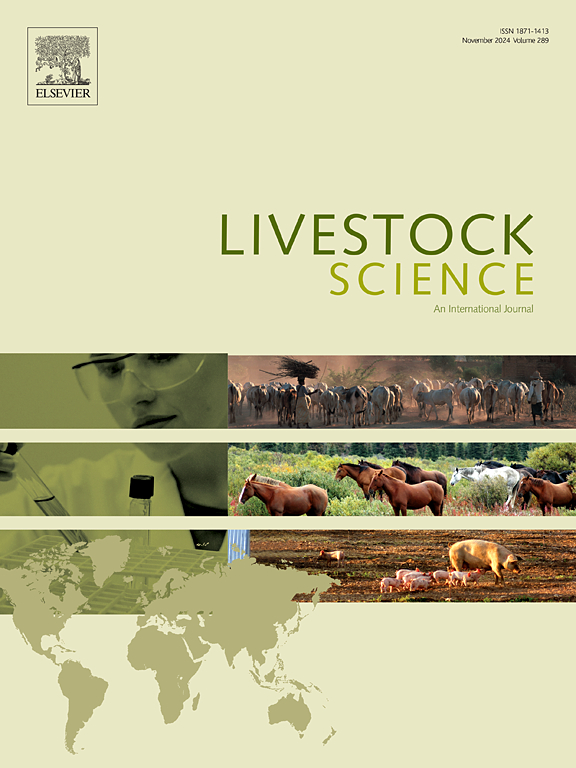Impact of feeding grass clover press cake silage to late lactation dairy cows on rumen fermentation parameters, nitrogen and phosphorus excretion and utilization
IF 1.9
3区 农林科学
Q2 AGRICULTURE, DAIRY & ANIMAL SCIENCE
引用次数: 0
Abstract
In the green biorefinery process, the biomass is mechanically separated into a solid and a liquid fraction. The biorefined silage obtained from this process has been shown to have potential as feed source for ruminants. However, little is known regarding the optimum level of biorefined silage in the diet of lactating dairy cows and the impact on production parameters and N and P excretion in late lactation cows. Six late lactation cows were used in a Crossover experiment consisting of 3 periods of 21-d each. Dietary treatments were offered ad libitum as TMR and were as follow: Grass-clover silage only (GS); 25 % grass-clover press cake silage (PC25); 50 % grass-clover press cake silage (PC50). All cows received 4 kg DM of concentrate per day. Milk production, milk composition, and rumen fermentation parameters were not affected by treatment. Milk urea (mg/100 mL) was lower for cows offered the PC25 and PC50 diet compared to those offered the GS diet. Dry matter intake and N digestibility were lower in cows offered PC50 diet, N intake (kg/d) was lower, urinary N output (kg/d) was 10 % lower but a higher proportion of N was excreted in feces. The PC50 diets also has a 24 % lower P intake and a 19 % lower fecal P (kg/d). Nitrogen use efficiency and PUE was higher for cows offered PC50. Compared to GS the PC50 diet maintains milk production and could potentially reduce the environmental impact of dairy production.
饲喂草三叶草压饼青贮对泌乳后期奶牛瘤胃发酵参数、氮磷排泄及利用的影响
在绿色生物炼制过程中,生物质被机械地分离成固体和液体部分。从该过程中获得的生物精制青贮饲料已被证明具有作为反刍动物饲料来源的潜力。然而,泌乳奶牛饲粮中生物精制青贮的最佳水平及其对泌乳后期奶牛生产参数和氮磷排泄的影响尚不清楚。选取6头泌乳后期奶牛进行交叉试验,共3期,每期21 d。饲粮处理为TMR,随机饲喂,分别为:纯草三叶草青贮;25%草-三叶草压饼青贮(PC25);50%草三叶草压饼青贮(PC50)。所有奶牛每天均饲喂4 kg干料精料。不同处理对产奶量、乳成分和瘤胃发酵参数均无影响。PC25和PC50饲粮的乳尿素(mg/100 mL)低于GS饲粮。饲喂PC50日粮的奶牛干物质采食量和氮消化率较低,氮采食量(kg/d)较低,尿氮排泄量(kg/d)较低10%,但粪便中氮排泄比例较高。PC50组饲粮磷摄入量降低24%,粪便磷(kg/d)降低19%。饲喂PC50的奶牛氮利用效率和PUE较高。与普通日粮相比,PC50日粮维持了牛奶产量,并可能减少乳制品生产对环境的影响。
本文章由计算机程序翻译,如有差异,请以英文原文为准。
求助全文
约1分钟内获得全文
求助全文
来源期刊

Livestock Science
农林科学-奶制品与动物科学
CiteScore
4.30
自引率
5.60%
发文量
237
审稿时长
3 months
期刊介绍:
Livestock Science promotes the sound development of the livestock sector by publishing original, peer-reviewed research and review articles covering all aspects of this broad field. The journal welcomes submissions on the avant-garde areas of animal genetics, breeding, growth, reproduction, nutrition, physiology, and behaviour in addition to genetic resources, welfare, ethics, health, management and production systems. The high-quality content of this journal reflects the truly international nature of this broad area of research.
 求助内容:
求助内容: 应助结果提醒方式:
应助结果提醒方式:


